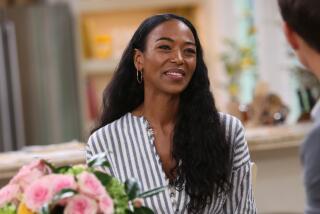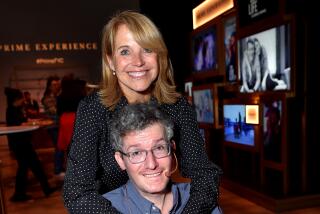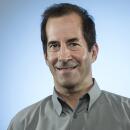4 Hearts, 1 Loving Marriage
- Share via
Mark Landau cringed when doctors said his wife needed a new heart. Six years earlier, he had been wheeled into the operating room at Cedars-Sinai Medical Center in Los Angeles for a heart transplant.
Wasn’t one per family enough?
Mark was more worried about his wife’s transplant than he had been about his own.
Would she have the stamina to get through the operation? he wondered. What about the shakes and hallucinations he had suffered when his body tried to reject the new organ? And the weight gain? And the hair that grew in the wrong places?
But after her initial trepidation, Sandra was as calm as someone in her situation could be. She had seen this movie before, and it had a happy ending. She’d have the same hospital, the same cardiologist, the same surgeon. Besides, it beat the alternative.
“I’ve never seen anyone so happy to have her heart ripped out,” said the Orange County couple’s 30-year-old daughter, Sarah.
Nearly 40,000 heart transplants have been performed in the U.S. since South African surgeon Christiaan Barnard pioneered the procedure in 1967. Doctors at Cedars-Sinai say the Landaus are the only husband and wife known to have had the operation.
No other married couple have experienced the parallel courses of roller-coaster emotions. Sandra and Mark each knew the despair of a dying heart and the surging hope for a renewed life. Each braced for the other’s death. Each felt the stress and joy of nursing a partner back to health.
Ultimately, their marriage survived, even thrived.
The role of nurse fell first to Sandra. After Mark’s transplant, she helped him shower, cleaned his bedpan and prodded him to walk. Then it was Mark’s turn, and he had to learn how to iron and use the washing machine and dryer.
Seven years after Mark’s operation, and a year after Sandra’s, they still prepare each other’s daily panoply of pills.
There are red ones, white ones, blue ones, green ones. There are pills to fight organ rejection, pills to build muscle, pills to fight the side effects of other pills. There are diuretics and antacids, supplements such as calcium and magnesium, and vitamins -- 24 pills a day for Sandra, 32 for Mark.
Sandra, 60, complains that the medicines make her an emotional mess and cause her hands to shake so badly that sometimes she can’t write, put food in her mouth or drive. She hopes that when she stops taking the anti-rejection drug prednisone Feb. 1, the shaking will end.
Mark, 54, complains that the medicines make his face so oily that he has to wipe it several times a day. Both say they sleep only an hour or two at a time, despite the slew of sleeping pills they have tried.
But it’s the price they pay for new lives. The Landaus spend more time together. They joke more and fight less. Once angry at life, Mark is more optimistic and carefree and worries less about money.
“We’re mellow,” Mark said. “She’s keeping me alive. I’m keeping her alive. I realize it’s not worth it to get aggravated. Perfection is in the imperfect mind.”
The Landaus moved to Orange County from New York in 1988. They live in a two-bedroom apartment in Rancho Santa Margarita. A painting above the living room couch symbolizes their newly relaxed attitude toward life. It shows a calm, sparkling-blue ocean with palm trees swaying in the wind.
The transplants were hardly the first challenge in the couple’s 32-year marriage. The variety store they owned in suburban New York was ruined in a flood, forcing them into bankruptcy and onto welfare and food stamps. They moved across the country to escape the wet and cold and start anew. Mark got a job as a paint store manager; Sandra sold shoes.
Doctors think a virus damaged Mark’s heart. Each winter in New York, he would catch the flu. His heart function would decline. Fluid would build up in his chest. He would become short of breath and end up in a hospital. Three times, he nearly died.
In California, his health improved dramatically -- until he caught the flu again and doctors told him he needed a new heart.
The diagnosis: idiopathic dilated cardiomyopathy, which meant that his heart was enlarged and pumped poorly; the precise cause of the condition was unknown.
“I was stunned,” he said. “I thought I’d solved all my problems. I was in good health all that time.”
He was placed on the national transplant list Oct. 3, 1996.
“Your whole life spins in front of your eyes,” Mark said. “Everything you’ve worked for seems to come to an end.”
When he told his wife that only a transplant could save him, she burst into tears. He broke the news to son Larry, then 20, and daughter Sarah, then 22.
“Everything went silent for a minute or two,” Larry recalled. “Then emotions broke out. I was the first to go. Then my sister started crying. Then my dad.”
The hospital gave Mark a pager so it could get in touch with him when a donor heart was ready. The first time it went off, he shook so hard he couldn’t press the buttons on the phone; he asked a co-worker to call the hospital.
It turned out it was the wrong number. Someone had called his pager by mistake. Twice more the pager went off because of wrong numbers.
The clock was ticking. He had been given 15 months to live, and when he reached the 16th, he was weak and tired. His legs were swelling, and his eyesight was failing.
He took a leave from his job at Vista Paint Corp. in Mission Viejo and prepared to die. He called a funeral director to ask the price of a cremation. He told Sandra she should remarry, because it was the only way she would be able to pay the bills.
A week later, Cedars-Sinai called. Mark had 2 1/2 hours to get to the hospital, where a heart would be waiting.
During the drive up the San Diego Freeway from Aliso Viejo, where the couple lived at the time, Mark was calm and joking. But when nobody seemed to be expecting him at the hospital, panic set in. He was shaking, talking gibberish. He stepped outside and called the transplant coordinator, who made sure the right people were there to admit him. By the time Mark had given his 14 vials of blood for last-minute tests, he had calmed down.
Mark worried how his wife would survive if he died. He was, after all, the protective father and husband who prided himself on working long hours at the paint store, supporting his aging mother and his blind brother along with his own family.
Mark and Sandra held hands as he was wheeled to the operating suite. It was April 15, 1997, the day Mark celebrates as his second birthday.
In the hospital chapel, Sandra prayed for two hours.
After the five-hour operation, she walked into Mark’s room and nearly fainted at the sight of one tube in his mouth, two in his stomach and one in each arm.
“He’s hooked up like Frankenstein,” she said.
Mark spent 25 days in the hospital, and for most of that time Sandra stayed in a room down the hall, going home only for a change of clothes. “I told them, ‘I’m not leaving,’ ” she said. “This was unknown territory. I didn’t know whether he’d make it or not.”
They held hands, watched TV, talked. Sandra became friendly with a woman whose husband had undergone a double lung transplant, and they took walks and ate lunch together.
Mark’s body began to reject the heart a week after surgery, and doctors adjusted his medicines, trying to find the right combination. On the eighth day, he got out of bed, took two steps and fainted. Another time, he hallucinated, jumped out of bed, pulled the tubes out of his arm and ripped off his hospital gown.
The residual pain from the surgery was so intense that Mark sometimes wished he would die. “My chest felt like it was caving in,” he said.
When Mark returned home, Sandra became his nurse. She monitored his oxygen tank, gave him sponge baths, awoke at 5 a.m. to prepare his daily intravenous antibiotic and sat with him in the bathroom when he had enough strength to take a shower.
Mark would wake up at night to find Sandra holding her head next to his nose to make sure he was breathing. Sometimes, she’d wake him to make sure he was alive.
“Leave me alone,” he growled. “Let me sleep.”
Normally not much of a reader, Mark consumed 23 books. He read “Harvest,” a novel about a heart transplant, in a single day.
Soon he tired of reading and watching television. “I was a chained tiger,” he said.
Most heart transplant patients wait six months to a year before returning to work. But against the wishes of his family and his doctors, Mark went back after just three months -- for a few hours a day at first. Two months later, he was working full time.
Mark recovered fully, and the couple thought their future was secure when, in 2001, they received stunning news:
Sandra had fainted at Macy’s in Laguna Hills, where she sold shoes. Tests showed she’d had a heart attack and suffered from hardening of the arteries and congestive heart failure, the result of heredity and diabetes.
“They told us there was a 40% chance I’d live four to 10 years,” she said. “Whatever that means, I still don’t know. But it’s not kosher.”
Her internist said her heart was in such bad shape that she wasn’t a candidate for bypass surgery. Mark called Cedars-Sinai, and doctors there agreed to see his wife. Sandra began a yearlong battery of tests to determine whether she was a transplant candidate.
While they were waiting, the Landaus took the longest vacation of their marriage, wondering if it would be their last. In August 2002, they flew to Maui for a month and visited the site of their honeymoon nearly 30 years earlier.
Their activities were limited -- no mai-tais, no water skiing, no snorkeling. They couldn’t sun themselves on the beach because of Mark’s anti-rejection drugs. They took pleasure in the sunsets and the hundreds of birds that alighted on their patio each day.
Tearfully, they broached the subject of Sandra’s possible death, her funeral, who should be called and how to help the children deal with it.
Back home, Sandra’s health deteriorated so badly that doctors surgically implanted a defibrillator to assist her failing heart. She grew so tired that she could barely read or watch TV.
Sandra was placed on the transplant list June 13, 2003. At first, “I cried like hell,” she said. “I knew what Mark went through, and it was scary, and I didn’t know if I’d come out of it dead or alive.”
Mark didn’t think his wife could survive. “It took me two days to compose myself,” he said. “I couldn’t go to work. I was crying to friends on my cellphone. I was just shocked.”
Sandra, who long ago had stopped attending synagogue, began praying three times a day at home. She prayed that she would live to see her two children marry, to have grandchildren, to have a full life with Mark.
After a four-month wait, Sandra got the call Oct. 14, 2003, that a heart was ready for her. She called her husband at the paint store. This time he would be in the waiting room.
As Sandra was being readied for surgery, cardiologist Lawrence Czer stopped by her bed. Czer is a man of science, but also a churchgoing Protestant who believes God works through him.
He asked the Landaus if he could pray with them. They held hands as the doctor asked for God’s help.
About five hours later, surgeon Alfredo Trento walked into the waiting room to tell Mark the operation had gone well.
“You know who I am?” Mark said.
“No,” the surgeon answered.
“You did me,” Mark said.
“I did you?”
“Yes, you did my heart transplant.”
The name came back to him, and the doctor smiled.
Sandra gained from six years of scientific advances since her husband’s surgery -- improvements in surgical techniques and organ preservation, better drugs to fight organ rejection and treat postoperative complications.
The day after her transplant, Sandra was sitting up and sipping water. “It’s like they plugged the heart in, and she’s up and running,” Mark said.
Though Mark had been bedridden for six weeks, Sandra left the hospital after only eight days. On her second day home, she walked a quarter-mile.
Now it was Mark’s turn to nurse, and he took three weeks off to care for his wife. He was a good cook, but now he had to run the house. Even when he caught a cold and slept on the couch to avoid infecting Sandra, he got up every half-hour to check on her.
Things went so well that after 10 days, Mark got bored and went back to work.
Although Sandra’s recovery has been relatively uneventful, it doesn’t mean she and Mark can forget that other people’s hearts are beating in their chests.
The hospital released some details about the donors but not their names. Mark’s donor was an 18-year-old man who died in a motorcycle accident in Southern California. Sandra’s was a woman in her late 20s who died a natural death in Northern California.
The Landaus are always mindful of the fragility of life. They know the buffet of drugs they will have to take for the rest of their lives may damage their livers and kidneys and can cause cancer.
They were lucky that Mark’s health insurance covered the cost of their operations and follow-up care. Nevertheless, they exhausted most of their savings during the transplant ordeals because each stopped working while the other recovered.
Now, they spend more than $300 a month on drug co-payments. They have no life insurance, and they drive an 11-year-old Toyota and a 6-year-old Thunderbird. But they are not complaining.
Sandra thanks God for keeping her and Mark alive, for the heart doctors and for the heart donors and their families.
Mark says his transplant was akin to winning “a lottery on life. All I see is brightness on the horizon.”
His e-mail address includes the phrase “nulife.”







